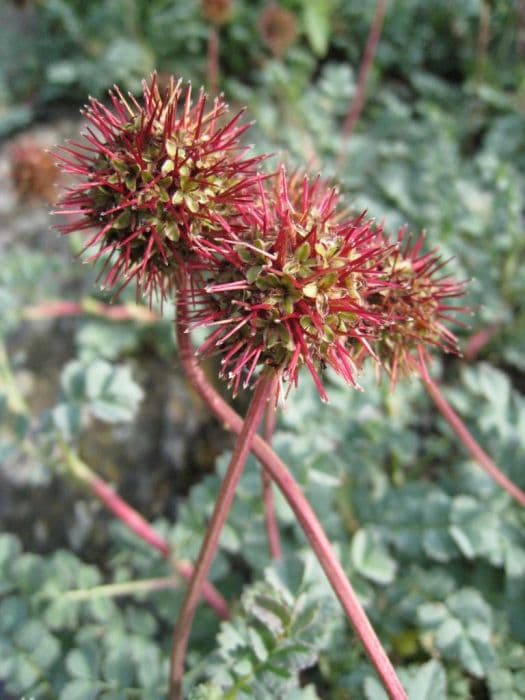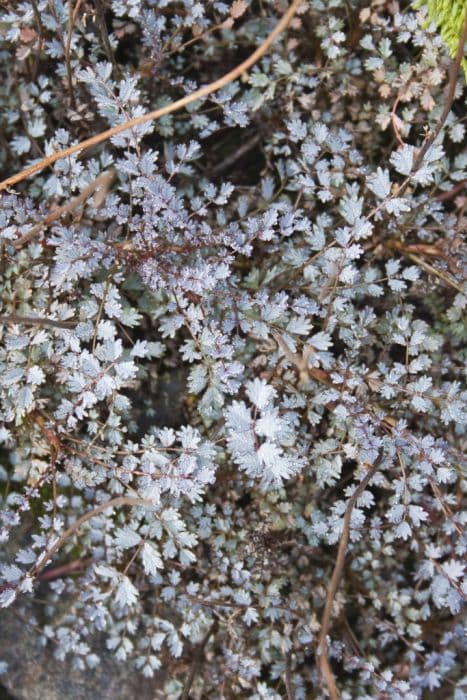Ghost Bramble Rubus thibetanus

ABOUT
The plant known by the common name Ghost Bramble showcases an intricate and enchanting appearance that captures the attention of gardeners and plant enthusiasts. During winter, the most striking feature of this plant becomes prominent – its stems turn into a dazzling silvery-white hue that truly stands out against the often bleak winter garden. When light catches these ghostly canes, they seem to glow with an ethereal brilliance. Throughout the warmer seasons, the plant is adorned with leaves that possess a green shade on their upper surface and a soft, felt-like underside that tends to be paler. The foliage gently tapers to a point and the edges may be jagged with fine serrations, adding texture to the overall lushness of the plant. This deciduous plant also produces flowers which can introduce a dash of color when they bloom. The flowers are modest in size and typically have a softer, lighter tone, which can range from white to pale pink. They are appealing to bees and other pollinating insects, contributing to the ecological value of the plant. With the arrival of autumn, the foliage undergoes a transformation, with the leaves taking on richer tones before eventually falling away. This exposes the striking winter stems and the cycle of visual interest continues. Additionally, after the flowering period, the Ghost Bramble may produce fruit that further adds to its ornamental appeal. These small, fruit can vary in color but often have that dark, perhaps almost black-looking tone when ripe. They can offer a food source for wildlife, as birds in particular find them quite attractive. Overall, the Ghost Bramble is a plant of contrasts – from its enchanting winter whiteness that stands stark against the cold season's surroundings, to its summer greens and floral hues, followed by autumnal richness before shedding its leaves for the winter spectacle. The plant's beauty lies in its evolving appearance through the seasons, providing year-round interest and never failing to make a statement in any garden space where the sizes such as feet, inches, or meters are not the primary focus.
About this plant
 Names
NamesFamily
Rosaceae
Synonyms
Tibetan Bramble, Ghost Bramble, Himalayan Bramble
Common names
Rubus thibetanus, Rubus bambusarum, Rubus fuscus, Rubus nutans, Rubus thibetanus var. khasianus.
 Toxicity
ToxicityTo humans
The plant in question, Rubus thibetanus, commonly known as the Himalayan blackberry, is not typically regarded as highly toxic to humans. In fact, various species of the Rubus genus provide edible fruit, and the blackberries are often consumed without issues. However, as with many plants, there are parts that may not be suitable for ingestion or could cause mild irritation or allergic reactions in some individuals. Consumption of leaves or other non-fruit parts of the plant is inadvisable and could potentially cause gastrointestinal discomfort due to the presence of tannins and other compounds. Eating unripe fruit might also cause some individuals to experience mild nausea or digestive upset. However, serious poisoning from ingesting this plant is uncommon.
To pets
The Himalayan blackberry is also not commonly known to be highly toxic to pets. While the fruit is generally safe for consumption, other parts of the Rubus thibetanus, like the leaves or stems, could potentially cause mild gastrointestinal upset in pets if ingested in significant quantities due to the presence of tannins and other plant compounds. Pets might experience symptoms such as vomiting or diarrhea if they consume non-fruit parts of the plant. It is always advisable to prevent pets from indiscriminate ingestion of plant material as idiosyncratic reactions can occur. If a pet is suspected to have eaten a large amount of the plant and is showing symptoms, it is advisable to consult a veterinarian.
 Characteristics
CharacteristicsLife cycle
Perennials
Foliage type
Deciduous
Color of leaves
Green
Flower color
White
Height
6 feet (1.8 meters)
Spread
5 feet (1.5 meters)
Plant type
Shrub
Hardiness zones
7
Native area
China
Benefits
 General Benefits
General Benefits- Aesthetic Appeal: Rubus thibetanus, commonly known as Tibetan blackberry, adds visual interest to gardens with its striking silvery white stems and thorn-like prickles.
- Habitat for Wildlife: It provides shelter and nesting opportunities for birds and small mammals.
- Food Source for Fauna: The fruit of the Tibetan blackberry serves as a food source for a variety of wildlife, including birds and insects.
- Erosion Control: The plant's extensive root system helps to stabilize soil and control erosion.
- Biodiversity: By including native species like Rubus thibetanus in landscaping, gardeners can support local ecosystems and promote biodiversity.
- Seasonal Interest: It has a seasonal cycle that includes flowering and fruiting, which adds changing interest throughout the year.
- Privacy Screen: Due to its dense growth habit, Tibetan blackberry can be used as a natural privacy screen or hedge.
- Cultural Significance: In some cultures, the plant may have traditional significance or be part of local culinary practices.
 Medical Properties
Medical Properties- This plant is not used for medical purposes
 Air-purifying Qualities
Air-purifying QualitiesThis plant is not specifically known for air purifying qualities.
 Other Uses
Other Uses- Rubus thibetanus, commonly known as ghost bramble, can be used as a natural barrier or hedge due to its thorny and dense growth habit, which can deter unwanted wildlife and human intrusion.
- The ghost bramble's striking silver-white stems provide winter interest in ornamental gardens, often used for contrasting against evergreens or colorful winter plants.
- With training and pruning, Rubus thibetanus can be fashioned into living sculptures or garden art, taking advantage of its visually arresting stems.
- The plant's dense, prickly thickets offer nesting sites and shelter for small birds, serving as a wildlife-friendly garden addition.
- Ghost bramble can be used in erosion control projects on slopes or banks due to its spreading nature and root system that helps to stabilize the soil.
- Its branches can be harvested and used in floral arrangements or as decorative elements in wreaths and other crafts, especially when its unique stem color is desired.
- Gardeners sometimes use ghost bramble as a companion plant to dissuade animals from damaging more vulnerable plants, utilizing its protective thorny barrier.
- During winter, the reflective quality of the plant's canes can brighten up dark areas of a garden by reflecting any available light.
- The fibers from the canes of Rubus thibetanus can be used in the creation of small handcrafted items like baskets or mats, though this use is not common.
- Some enthusiasts of bonsai cultivate ghost bramble for its distinct appearance and potential for training into miniature tree forms.
Interesting Facts
 Feng Shui
Feng ShuiThe Ghost Bramble is not used in Feng Shui practice.
 Zodiac Sign Compitability
Zodiac Sign CompitabilityThe Ghost Bramble is not used in astrology practice.
 Plant Symbolism
Plant Symbolism- Endurance: The Rubus thibetanus, commonly known as the "Ghost Bramble," is known for its ability to survive in tough conditions, symbolizing the strength to endure hardships.
- Protection: With its thorny branches, the Ghost Bramble provides a natural barrier, which can represent protection from negative influences or harm.
- Intrigue: The striking silvery-white appearance of its stems, especially in winter, adds an air of mystique and intrigue, symbolizing the unknown or magical elements of nature.
- Adaptability: This plant's ability to thrive in various environments signifies adaptability and flexibility in life's circumstances.
- Purity: The Ghost Bramble's unique color is often associated with purity and innocence, standing out in stark contrast to its surroundings.
- Beauty in adversity: Blooming even in the harshest of winters, the Ghost Bramble can represent the idea that beauty and grace can exist amidst adversity.
 Water
WaterThe Ghost Bramble, commonly known as Rubus thibetanus, should be watered deeply but infrequently to mimic natural conditions. During the growing season, water the plants with about 1-2 gallons per week, depending on the weather. Check the top 2-3 inches of soil before watering; if it's dry, it's time to water. During the winter, you can reduce watering as the plant goes dormant, but don't allow the soil to become completely dry. Overwatering can lead to root rot, so ensure proper drainage.
 Light
LightGhost Bramble thrives best in full sun to partial shade. The ideal spot for this plant is where it can receive at least six hours of sunlight daily, though it can tolerate some afternoon shade. Avoid placing it in deep shade, as this can lead to poor growth and fewer flowers.
 Temperature
TemperatureGhost Brambles are hardy and can withstand a range of temperatures but grow best when the temperature is between 60°F and 75°F. They can survive minimum temperatures down to around 5°F but may suffer damage if exposed to extended periods of cold. Avoid placing them in locations where temperatures exceed 80°F for prolonged periods as this may stress the plants.
 Pruning
PruningPruning Ghost Brambles helps maintain their shape, encourage new growth, and remove any dead or diseased wood. Prune in late winter or early spring before new growth starts. This is also the time to cut back any canes that fruited the previous year, as Ghost Bramble fruits on second-year wood. Thin the plants to allow air circulation, reducing the risk of disease, and prune them every year to keep them vigorous.
 Cleaning
CleaningAs needed
 Soil
SoilGhost Bramble prefers well-draining soil with a pH between 5.5 and 7.5. A loamy mix with organic matter added, such as compost or well-rotted manure, can nourish the plant while providing adequate drainage. Regular mulching can help maintain moisture levels and soil structure.
 Repotting
RepottingGhost Bramble should be repotted every 2 to 3 years to refresh the soil and accommodate root growth. Larger containers should be used as the plant matures, ensuring there's enough space for root development.
 Humidity & Misting
Humidity & MistingGhost Bramble thrives in average to high humidity levels, but it is adaptable and can tolerate a range of humidity conditions. Ensuring good air circulation can help prevent fungal diseases in higher humidity environments.
 Suitable locations
Suitable locationsIndoor
Provide bright light, cool temps, and prune regularly.
Outdoor
Full sun to partial shade, protect from strong winds.
Hardiness zone
7-9 USDA
 Life cycle
Life cycleRubus thibetanus, commonly known as Tibetan bramble or ghost bramble, begins its life cycle as a seed, typically dispersed by wildlife or environmental factors. Upon germination, which requires exposure to cold temperatures to break dormancy, the seedling emerges and develops a root system and foliage, entering its vegetative growth stage. As a perennial plant, the Tibetan bramble then matures and annually produces canes from the rootstock, which can be biennial - leaves and photosynthetic growth in the first year, and flowers and fruits in the second. After pollination, often facilitated by insects, the plant produces berries containing seeds, which are then ready to be dispersed, completing the reproductive stage. In subsequent years, the plant continues to grow vegetatively while initiating new reproductive cycles each season. With the onset of colder weather, the above-ground parts may die back, while the root system remains alive to regenerate the following spring.
 Propogation
PropogationPropogation time
Early spring
The most popular method for propagating Rubus thibetanus, commonly known as the ghost bramble, is through semi-hardwood cuttings. This technique involves taking cuttings of the plant's mature stems during the late summer. The cuttings should be about 4 to 6 inches (10 to 15 centimeters) long, with several leaves left at the top. The lower leaves should be removed, and the cut end dipped into rooting hormone powder to enhance root development. The prepared cuttings are then placed into a pot filled with a mixture of peat and perlite or sand to provide good drainage and moisture retention. The pot should be kept in a warm, shaded area and the soil should be kept consistently moist but not waterlogged. Roots typically develop within a few weeks, after which the new plants can be gradually acclimated to more direct sunlight and eventually transplanted outdoors.









